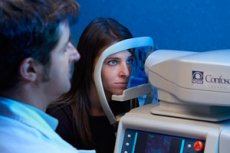
All iLive content is medically reviewed or fact checked to ensure as much factual accuracy as possible.
We have strict sourcing guidelines and only link to reputable media sites, academic research institutions and, whenever possible, medically peer reviewed studies. Note that the numbers in parentheses ([1], [2], etc.) are clickable links to these studies.
If you feel that any of our content is inaccurate, out-of-date, or otherwise questionable, please select it and press Ctrl + Enter.
Confocal lifetime microscopy of the cornea
Medical expert of the article
Last reviewed: 06.07.2025

Confocal microscopy of the cornea is one of the modern research methods; it allows for intravital monitoring of the cornea with tissue visualization at the cellular and microstructural level.
This method, due to the original design of the microscope and its high resolving power, allows visualization of living corneal tissue, measurement of the thickness of each of its layers, and assessment of the degree of morphological disorders.
The purpose of corneal confocal microscopy
To characterize the morphological changes of the cornea that occur in various inflammatory and dystrophic diseases, as well as as a result of surgical interventions and exposure to CL.
Morphological examination data are necessary to assess the severity of the pathological process, the effectiveness of treatment and to determine the tactics of patient management.
Indications for the procedure
- Inflammatory diseases of the cornea ( keratitis ).
- Dystrophic diseases of the cornea ( keratoconus, Fuchs dystrophy, etc.).
- Dry eye syndrome.
- Conditions after surgical interventions on the cornea (penetrating corneal transplant, keratorefractive surgeries).
- Conditions associated with contact lens wearing.
Preparation
Who to contact?
Technique confocal microscopy of the cornea.
The study is performed using a ConfoScan 4 (Nider) confocal microscope with a magnification of 500 times. The device allows the cornea to be examined throughout its entire thickness.
The size of the examined area is 440×330 μm, the scanning layer thickness is 5 μm. The lens with a drop of gel is brought to the cornea until it touches and is installed so that the thickness of the immersion liquid layer is 2 mm. The design of the device allows examining the cornea in the central zone and its paracentral areas.
Normal performance
Normal morphological picture of the cornea
The anterior epithelium consists of 5-6 layers of cells. The average thickness of the entire epithelium is approximately 50 µm. According to the morphological structure, the following layers are distinguished (from the inside out): basal, awl-shaped cells and superficial.
- The innermost (basal) layer is represented by small, dense, cylindrical cells without a visible nucleus. The boundaries of the basal cells are clear and bright.
- The middle layer consists of 2-3 layers of spiny (winged) cells with deep invaginations into which the outgrowths of neighboring cells are embedded. Microscopically, the cell boundaries are quite clearly distinguishable, and the nuclei may not be defined or may be unclear.
- The superficial layer of the epithelium is represented by one or two layers of polygonal cells with clear boundaries and homogeneous density. The nuclei are usually brighter than the cytoplasm, in which a perinuclear dark ring can also be distinguished.
Among the cells of the superficial layer, dark and light cells are distinguished. Increased reflectivity of epithelial cells indicates a decrease in their metabolic rate and their beginning desquamation.
Bowman's membrane is a transparent structure that does not reflect light, so it is normally impossible to visualize it with confocal microscopy.
The subbasal nerve plexus is located under Bowman's membrane. Normally, nerve fibers appear as bright stripes running parallel on a dark background, contacting each other. Reflectivity (reflectivity) may be uneven along the fiber.
The corneal stroma occupies 80 to 90% of the cornea's thickness and consists of cellular and extracellular components. The main cellular elements of the stroma are keratocytes; they make up approximately 5% of the volume.
A typical microscopic picture of the stroma includes several bright irregular oval-shaped bodies (keratocyte nuclei) that lie in the thickness of a transparent dark gray or black matrix. Normally, visualization of extracellular structures is impossible due to their transparency. The stroma can be conditionally divided into sublayers: anterior (located directly under the Bowman's membrane and makes up 10% of the stroma thickness), anterior-middle, middle, and posterior.
The average density of keratocytes is higher in the anterior stroma, gradually decreasing towards the posterior layers. The density of anterior stromal cells is almost twice as high as that of posterior stromal cells (if the density of anterior stromal cells is taken as 100%, then the density of posterior stromal cells will be about 53.7%). In the anterior stroma, the nuclei of keratocytes have a rounded bean-shaped form, while in the posterior stroma they are oval and more elongated.
Keratocyte nuclei may vary in brightness. The different ability to reflect light depends on their metabolic state. Brighter cells are considered to be activated keratocytes ("stress" cells), whose activity is aimed at maintaining the internal homeostasis of the cornea. In the norm and visual field, single activated cells are found.
Nerve fibers in the anterior corneal stroma are visualized as bright homogeneous bands, often forming bifurcations.
Descemet's membrane is normally transparent and is not visualized by confocal microscopy.
The posterior epithelium is a monolayer of hexagonal or polygonal flat cells with a uniformly light surface against a background of clear dark intercellular boundaries.
The device has the ability to manually or automatically calculate cell density, their area and variability coefficient.
Pathological changes in the structure of the cornea
Keratoconus is characterized by significant changes in the anterior epithelium and stroma of the cornea.
 [ 12 ], [ 13 ], [ 14 ], [ 15 ], [ 16 ], [ 17 ], [ 18 ], [ 19 ], [ 20 ]
[ 12 ], [ 13 ], [ 14 ], [ 15 ], [ 16 ], [ 17 ], [ 18 ], [ 19 ], [ 20 ]

